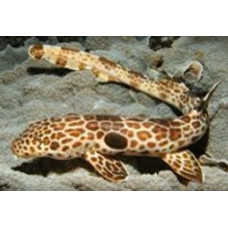Latin name
Hemiscyllium galei
Other name
Hemiscyllium galei
Identification
The Cenderawasih epaulette shark has no hood on its head from snout to gills. These sharks have a rather elongated, slender body with a short snout, and the anteroposterior distance is less than 3% of body length. The eyes and perorbital ridges are raised. The nostrils are located at the tip of the snout. They are framed by short antennae, less than 1.3% of body length. The mouth is located in front of the eyes and is moved closer to the tip of the snout. The folds of the lower lip are not joined by a skin fold at the chin. The distance to the premaxilla is less than 13% of the body length. There are spiracles behind the eyes.
Features of fish fins
The distance from the anal opening to the beginning of the base of the anal fin is over 38% of the body length. Pectoral and ventral fins are thick and muscular. There are no spines at the base of the dorsal fins. Dorsal fins of equal size, set back. The base of the first dorsal fin is posterior to the base of the pelvic fins. The caudal peduncle is very long. The long anal fin is just in front of the caudal fin. The caudal fin is asymmetrical, elongated, with a ventral notch at the edge of the upper lobe, the lower lobe is undeveloped.
Fish colouring
The back of this shark species is covered with dark saddle-shaped markings edged in white, as well as randomly scattered white spots, while the belly is covered with a series of 7-8 well-defined oval and horizontally elongated dark spots. Above the pectoral fins are characteristic round "epaulette" shaped markings.
Distribution
They live in a restricted area in the western Pacific Ocean off the coast of West Papua, Indonesia.
Habitat
Tropical marine species. These sharks are found close to shore on coral reefs at depths of 2-4 meters.
Size
The maximum recorded length of the Cenderawasih epaulette shark is 57 cm.
Behavior
Hemiscyllium galei are nocturnal. They usually lie on the bottom, sometimes swimming slowly or "walking" on the bottom with pectoral and pelvic fins. During the day they hide in the crevices of the reef or under stony corals.
Food and feeding habits
Nothing is known about the feeding habits and diet of these sharks, but they are thought to feed on bottom-dwelling animals, their larvae and juvenile bony fish.
Reproduction
Believed to be an egg-laying species of shark.
Fishing
The species is not targeted by commercial fisheries.
Relationship with a person
Harmless.
| Classification | |
| Phylum | Chordata |
| Class | Chondrichthyes |
| Squad | Orectolobiformes |
| Family | Hemiscylliidae |
| Genus | Hemiscyllium |
| Species | H. galei |
| Features | |
| Conservation status | Vulnerable |
| Habitat | Pelagic |
| Life span, years | No information |
| Maximum body weight, kg | No information |
| Maximum length, cm | 57 |
| Sailing speed, m/s | No information |
| Threat to people | Not edible |
| Way of eating | Predator |

